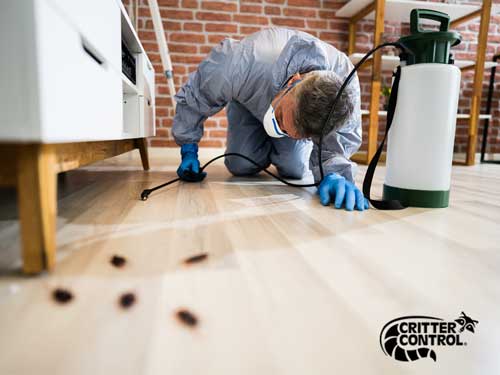A1 Charlotte Pest Control Companies - Your Regional Pest Experts
A1 Charlotte Pest Control Companies - Your Regional Pest Experts
Blog Article
Bed Pest Treatment Malfunction: Contrasting Chemical Vs. Non-Chemical Solutions
In the realm of bug control, particularly when managing the consistent concern of bed bugs, the selection between chemical and non-chemical therapy services can be a pivotal one. Both methods supply distinct benefits and disadvantages, affecting elements such as performance, safety considerations, and general cost. By taking a look at the nuanced information of each approach, a more clear understanding of which path to go after in addressing a bed insect infestation can be obtained.
Effectiveness of Chemical Treatments
Chemical treatments for bed bug infestations have been extensively acknowledged for their powerful and fast effectiveness in removing these pests. When considering the performance of chemical therapies, it is essential to recognize that they can provide a thorough and quick solution to a bed insect issue. Specialist pest control experts typically rely on pesticides to target bed pests at different phases of their life process, consisting of eggs, nymphs, and adults. These chemicals usually work by interfering with the bed pests' anxious system, leading to paralysis and eventual death.
Moreover, chemical treatments have the advantage of offering recurring impacts, meaning that they can proceed to remove bed bugs also after the preliminary application. This residual action is specifically beneficial in combating any possible re-infestations. Additionally, the fast activity of chemical treatments can bring relief to people encountering serious bed bug problems, allowing them to restore control of their space quickly.
Security Worry About Chemical Solutions
When making use of chemical options for bed insect treatment is guaranteeing the safety of occupants and the atmosphere,One essential aspect that needs cautious factor to consider. While chemical treatments can be efficient in eradicating bed pests, they may position dangers otherwise dealt with effectively. Among the primary safety and security concerns with chemical solutions is the prospective injury they can create to human wellness. Exposure to particular chemicals made use of in bed pest treatments can lead to respiratory issues, skin irritation, or other unfavorable reactions, specifically in individuals with pre-existing conditions or level of sensitivities. In addition, inappropriate application or dosage of chemical pesticides can result in toxic residues lingering in the cured area, posing long-lasting health risks to residents.
Additionally, the ecological impact of chemical options is one more significant factor to consider. Some pesticides used in bed pest treatments may be damaging to advantageous pests, wild animals, and ecological communities if they leach into the soil or water supply. It is vital to make use of chemical treatments deliberately, following security standards, and considering less hazardous options to minimize these threats and ensure the safe and reliable administration of bed bug invasions.
Benefits of Non-Chemical Techniques
Thinking about the possible security worries and ecological effect linked with chemical options for bed insect treatment, exploring non-chemical approaches offers an appealing option with numerous unique benefits. Non-chemical methods supply a much safer alternative for households, specifically those with youngsters, people, or animals conscious extreme chemicals. These strategies get rid of the threats of exposure to poisonous substances, minimizing the possibility for adverse health and wellness results. Additionally, non-chemical therapies are environmentally pleasant, as they do not contribute to air or water contamination, making them a lasting choice for insect control.
Furthermore, non-chemical services can be reliable in targeting bed pests, consisting of hard-to-reach locations where chemical treatments may not penetrate. Methods such as warmth therapy, vacuuming, vapor cleaning, and bed mattress coverings give complete obliteration without using unsafe chemicals. Additionally, non-chemical methods can be less turbulent, requiring marginal preparation and permitting for quicker reentry right into treated locations. On the whole, going with non-chemical bed bug treatment methods not only focuses on safety and security and environmental management however additionally makes certain detailed and reliable parasite control.
Limitations of Non-Chemical Treatments

Furthermore, non-chemical treatments typically call for numerous applications to achieve successful obliteration. This can be taxing and might not constantly assure total removal of all bed bugs and their eggs, particularly in hard-to-reach or surprise places.
Moreover, the success of non-chemical treatments heavily depends on appropriate application and thoroughness, which can be challenging for individuals without expert expertise. Inadequate application of non-chemical techniques may lead to insufficient obliteration, leading to persistent infestations and the need for extra therapies.
Consequently, while non-chemical therapies have their benefits, it is necessary to acknowledge these restrictions and consider them when identifying the most reliable method for managing bed bug infestations.
Cost Contrast: Chemical Vs. Non-Chemical Options
Provided the restrictions related to non-chemical treatments, a vital element to assess in the context of bed insect monitoring is the expense comparison between chemical and non-chemical alternatives. Chemical therapies normally include the application of pesticides by professionals, which can range from $250 to $900 per room, depending upon the severity of the problem and the size of the area to be dealt with. In comparison, non-chemical treatments like heat treatment or steam can be more pricey, with expenses ranging from $1,000 to $6,000 for an entire home. While the preliminary price of chemical YOURURL.com therapies may seem reduced, multiple therapies might be required to completely get rid of the invasion, potentially increasing the overall price. On the various other hand, non-chemical options may supply a more sustainable and environment-friendly solution, although they can be cost-prohibitive for some people. Ultimately, when taking into consideration the expense of bed bug therapy options, it is important to evaluate the upfront costs against the efficiency and long-term sustainability of the picked method.
Final Thought

Considering the possible safety and security worries and ecological influence associated with chemical services for bed bug therapy, checking out non-chemical techniques presents an appealing choice with a number of distinct advantages.Provided the limitations connected with non-chemical treatments, a necessary aspect to review in the context of bed insect management is the price comparison in between chemical and non-chemical choices. In comparison, non-chemical treatments like heat therapy or steam can be a lot more expensive, with prices ranging from $1,000 to $6,000 for a whole home. While the first expense of chemical treatments may appear lower, several treatments may be called for to completely eradicate the invasion, possibly enhancing the general expense.In verdict, when comparing chemical and non-chemical bed pest treatment choices, it is necessary to take into consideration performance, safety, benefits, constraints, and cost.
Report this page